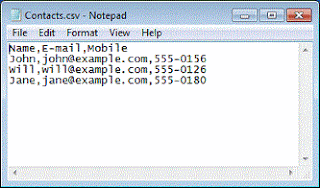 |
| This is a .CSV file, Blake |
We'd already been through this with Amy Dombrower's original version of the post, but what the heck. Let's see what the website fileinfo.com has to say about .DAT files:
"DAT files are typically accessed only by the application that created them. Many programs create, open, or reference DAT files."In other words, if you want to change a DAT file to a CSV, the most likely solution is to open the file in the software that created it and perform an export. Otherwise, you're probably left looking for someone to write a special program². Flournoy did little to change Dombrower's original, beginning with an introduction making the bogus claim that,
"Word processors, internet browsers, video games and audio/visual editing software all use the DAT file type to operate properly... While you can use basic text editors like Notepad to open DAT files, it can be more effective to examine the data inside through the use of a spreadsheet."Well no, Blake, you usually can't because "[word] processors, internet browsers, video games and audio/visual editing software" typically store data files in proprietary binary formats. That's not to mention that most of the time the data structures stored in DAT files don't lend themselves to spreadsheet viewing. |
Flournoy continues to amaze with their lack of knowledge about file structures, "explaining" that,
"Because DAT files use plain text and binary code, often grouped together to begin with, many of them can easily be converted to CSV... files."Ummm, Blake? CSV files are plain text, and ordinary humans cannot "easily" convert binary to plain text. Besides that, your next sentence suggests that you don't even know what a CSV file is:
"[CSV] files segment data into tables through the use of commas, which can be placed into a spreadsheet by files like Excel."No, Blake. First, CSV files segment data into fields, not "tables"; and second, Excel is a program, not a "file"! There is, of course, more dumbassery to come. Flournoy merely rewords the bogus suggestions Dombrower made, including,
- Simply rename the file.
- Right click and "open with" Excel, then save as CSV.
- Use a "DAT file converter" to make it "compatible" or convert to a CSV
¹ We're still wondering how Blake could have written this before Amy's version was ever up on Techwalla (March 31, 2015? really?)...
² Been there, done that.
copyright © 2019-2022 scmrak
SE - COMPUTERS
No comments:
Post a Comment